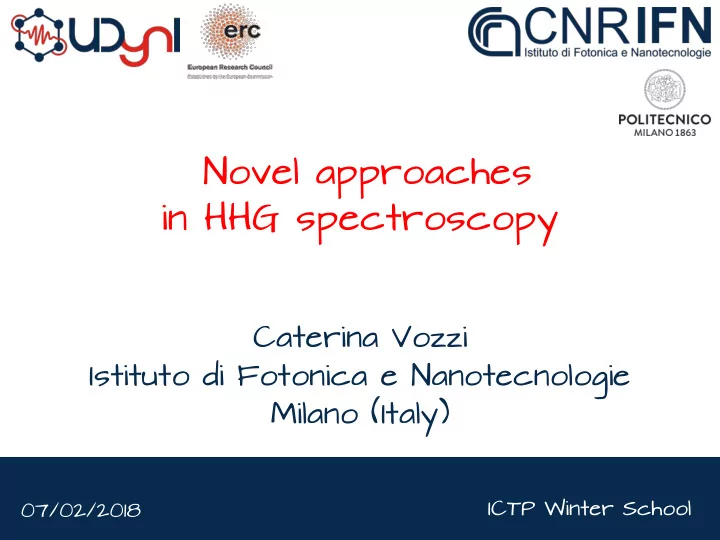

Novel approaches in HHG spectroscopy Caterina Vozzi Istituto di Fotonica e Nanotecnologie Milano (Italy) ICTP Winter School 07/02/2018
Outline A few reminders of HHG spectroscopy • the study of electron correlation in xenon: • experiments and interpretation perspective: • development of the molecular imaging lab @ IFN-CNR 2
High order harmonic generation I. Ionization: the laser field detaches an electron from the valence shell via tunnel ionization II. Propagation: the freed electron is accelerated by the laser field III. Recombination: the energy gained by the electron is released through the emission of a XUV photon 3
HHG driven by longer wavelength h ν cutoff = I p +3.17U p where U p ~ E 2 λ 2 well-developed plateau in fragile molecules • negligible contribution of multielectron effects • generation yield ~ λ - α with α ~ 5-6 but... 4
Lewenstein quantum model - Strong Field Approximation - Single Active Electron from the outermost valence shell II. propagation I. ionization III. recombination 5
Saddle point approximation & quantum trajectories II. propagation I. ionization III. recombination through the saddle point approximation - we find a coupling between: ionization time t s – τ s recombination time t s photon energy ħ Ω 6
Attosecond dynamics probed by HHG Each saddle point solution defines a quantum trajectory Shafir et al. Nature 485 85, 343 (2012) The attosecond nature of the process is mapped into the HHG spectrum! 7
Why xenon? it is not a complex system...but: it shows a high harmonic yield • it can be modeled “easily” • it shows electronic correlation • 8
Electron correlation in xenon first channel: the returning electron recombines directly with the 5p electron vacancy second channel: the returning electron promotes an electron of the 4d inner shell to the 5p valence shell via inelastic scattering and then it recombines with the 4d electron vacancy gia iant resona sonance aroun ound 10 100 eV V 9
Xenon giant resonance in HHG A. Shiner et al., Nat. Physics 7, 464 (2011) S. Pabst & R. Santra, Phys. Rev. Lett. 111 111, 233005 (2013) 10
how can we extract information about electron correlation from HHG measurement? by two-color HHG! 11
Two-color HHG spectroscopy Two possible polarization configurations: Perpendicular: Parallel: half-wave plate @ 1500 nm 12
Parallel configuration: method the symmetry between the two half cycles is broken cutoff 1 cutoff 2 this results in two classes of trajectories with two different cutoffs and ionization probabilities 13
Parallel configuration: method Ionization Ionization rate 1 rate 2 cutoff1 SAE cutoff2 lower branch upper branch suppressed cutoff 1 cutoff 2 Frolov et al., PRA 81, 063407 (2010) 14
Parallel configuration: results exp 5p time-dependent configuration interaction singles (TDCIS) calculations 5p + 5s + 4d by Stefan Pabst Qualitative and quantitative agreement with TDCIS calculations when all 5p, 5s and 4d orbitals are interacting D. Faccialà et al., Phys. Rev. Lett. 117, 093902 (2016). 15 •
Parallel configuration: interpretation the upper branch becomes visible in the HHG spectrum only when all 5p, 5s and 4d orbitals are interacting the GIANT RESONANCE counteracts the reduced ionization probability of the upper branch …Can we extract information on the electron- electron correlation from HHG spectra? In parallel polarization we cannot easily disentangle τ s,ts, Ω 16
Perpendicular configuration: method The second harmonic displaces the electron in the orthogonal direction, it acts as a gating which selects specific trajectories with a given energy There is an optimal phase delay φ between the two fields that maximizes the probability of recombination for each harmonic photon energy. φ ( Ω ) is a measure of the recombination time of the electron t r …it is a clock to probe dynamics! 17
Conclusions (1) The xenon giant resonance gives access to the observation of unrevealed features: In parallel polarization • it counteracts the reduced ionization probability of the upper branch In perpendicular polarization • it enhances the contribution of trajectories that are classically forbidden (2) We measured the delay induced by the process in the energy region of the cutoff trajectories the electron is accelerated during the recombination due to • the coulomb-exchange process. (3) Two-color HHG spectroscopy is sensitive to the phase of the dipole. 18
Perspectives: the new lab
A new lab @ CNR-IFN the laser source Dr Driv iving laser ser sour urce ce: <22 fs pulses 15 mJ energy 1 kHz repetition rate 20
The Udyni lab @ CNR-IFN manipulating the light Hig High ener energy OP OPA 1. 1.2 2 – 3 µm • <20 fs pulses • 2 mJ energy • CEP stable • + hollow fiber • 21
The Udyni lab @ CNR-IFN XUV XUV sp spec ectromet ometer VMI MI sp spec ectromet ometer • gratings @ 10 nm and 1 nm for electrons up to 200 eV • stigmatic/astigmatic • harmonic polarization detection 22
Aknowledgments Stefan Pabst
Aknowledgments ASPIRE ITN 24
caterina.vozzi@cnr.it www.udyni.eu www.mi.ifn.cnr.it/research/ultrafast/molecularimaging
Recommend
More recommend